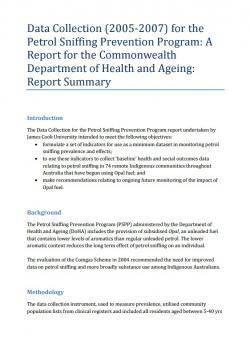Data collection for the Petrol Sniffing Prevention Program: report summary

This is a summary report on baseline data relating to petrol sniffing in 74 remote communities which initially began using Opal Fuel. This contains data collected between September 2005 and February 2007.
Introduction
The Data Collection for the Petrol Sniffing Prevention Program report undertaken by James Cook University intended to meet the following objectives:
-
formulate a set of indicators for use as a minimum dataset in monitoring petrol sniffing prevalence and effects;
-
to use these indicators to collect ‘baseline’ health and social outcomes data relating to petrol sniffing in 74 remote Indigenous communities throughout Australia that have begun using Opal fuel; and
-
make recommendations relating to ongoing future monitoring of the impact of Opal fuel.
Background
The Petrol Sniffing Prevention Program (PSPP) administered by the Department of Health and Ageing (DoHA) includes the provision of subsidised Opal, an unleaded fuel that contains lower levels of aromatics than regular unleaded petrol. The lower aromatic content reduces the long term effect of petrol sniffing on an individual.
The evaluation of the Comgas Scheme in 2004 recommended the need for improved data on petrol sniffing and more broadly substance use among Indigenous Australians.
Methodology
The data collection instrument, used to measure prevalence, utilised community population lists from clinical registers and included all residents aged between 5-40 yrs inclusive. People in the population lists were categorised by gender, quinquennial age-group, and categories of use shown below:
|
Category |
|
Definition |
|---|---|---|
|
Non sniffer |
|
Not known to have sniffed petrol or any other inhalant in past 6 months. |
|
Current sniffer |
Experimental |
Believed to have sniffed petrol or other inhalant in past 6 months, but no evidence of regular use. |
|
|
Regular |
Believed to have sniffed petrol or other inhalant regularly over past 6 months, but does not meet criterion of heavy use (i.e. at least once a week). |
|
|
Heavy |
Has sniffed petrol or other inhalants at least weekly (whenever inhalants are available), over past 6 months. |
The instrument used in this study was based on one developed by Nganampa Health Service used for conducting annual surveys of petrol sniffing in communities in the Anangu Pitjantjatjara Yankunytyjatjara (APY) Lands of South Australia.
The project was approved by the James Cook University Human Research Ethics Committee. Permission was sought from each community in the study prior to visits taking place. Wherever possible, data collection was carried out by fieldworkers already known in the community concerned.
The fact that individual communities switched to using Opal at different times, and that some communities had previously been supplying Comgas (subsidised Avgas), means that the data collected for this project should not be viewed as true baseline (that is pre-Opal) data. It should be instead viewed as a series of snapshots in time that provide a reference point for future comparisons.
Results
Prevalence
-
74 communities were approached to participate in the data collection activities:
-
in 47 cases the consultants were given direct access to the communities and relevant data;
-
in 8 cases the consultants utilised alternative sources of data, these included utilising the Nganampa Health Survey for 7 communities on the APY Lands and the other case was where the Central Australian Youth Link Up Service (CAYLUS) had just completed data collection;
-
in 12 cases, communities denied access on the grounds of no petrol sniffing in the community. In these cases, the consultants spoke to at least two key informants via phone to confirm the no sniffing status;
-
in one case the community identified 1 sniffer but would not allow further access to the community;
-
in two cases, the regional health board would not allow access to the population lists;
-
in two cases the consultants were unable to make contact with the communities due to remoteness and very small populations; and
-
in the remaining two cases the consultants were unable to make arrangements to visit the communities.
The following table provides a snapshot of the prevalence and the frequency of petrol sniffing across regions in Australia where baseline data has been collected. For the purpose of this summary, data has been reported at the regional level only. This is due to the sensitive nature of data relating to petrol sniffing and ensures the privacy of individual communities is maintained.
Table 1: Prevalence of sniffing in communities at the time of data collection, by region
|
Region |
Pop. 5 – 40 yrs |
No. of users |
% users |
Date of collection |
|---|---|---|---|---|
|
APY Lands |
1969 (10 – 40 yrs) |
219 |
11.1 |
Sept 05 |
|
Central Australia |
4418 |
244 |
5.5 |
Nov 05 – Feb 06 (1 community Feb 07) |
|
East Kimberley |
547 |
32 |
5.8 |
Jan 06 |
|
Eastern Goldfields |
92 |
5 |
5.4 |
Nov 06 |
|
Far North Queensland |
1861 |
96 |
5.2 |
Feb – May 06 |
|
Ngaanyatjarra Lands (WA) |
1035 |
145 |
13.9 |
Nov 05 - 06 |
|
Northern Central Australia sub region |
2188 |
1 |
.05 |
Oct 06 |
|
Southern Central Australia sub region |
619 |
102 |
16.4 |
Nov – Dec 05 |
|
Top End* |
12985 |
266 |
2 |
Sept 06 –Feb 07 |
|
Western Central Australia sub region |
1195 |
141 |
11.8 |
Dec 05 – Feb 06 |
*This figure may be artificially low due to a lack of data from 4 communities.
Note: The Central Australian region has been broken down into three distinct sub regions – Northern Central Australia, Southern Central Australia and Western Central Australia – in order to highlight more local variations. Alice Springs is not included in this data.
Health and social effect data
To measure the health effect indicator, data was collected on the number of presentations to a health clinic as a result of petrol sniffing. The low rate of presentations confirmed the observations of many health centre staff that sniffers tend not to present at the clinic.
The indicator chosen for social impact was juvenile charges by community. Data was only able to be obtained for communities in South Australia. The results of the South Australian data indicated no direct relationship between the number of offences and the number of inhalant users. The most sensitive indicator of the social impact of inhalant use appears to be, not the overall prevalence rate, but the rate of regular heavy use.
Recommendations
The report outlined the following recommendations:
-
The population list’ method for data collection worked well and should be used where the following conditions were met: fieldworker was known in the community, and had pre-existing relationships there; an accurate population list was available; and community population size did not exceed 700 people.
-
In communities of 1000+, data should be collected from key informant estimates rather than population lists to maximise the quality of data.
-
Due to the limited reliability of the data collected for the health effect and public-order indicators, it is suggested that future data is collected for the prevalence of petrol sniffing indicator only.
-
For future data collection, the regions used for the study should be consistent with those identified in this report.
-
A lower cost alternative to monitoring all communities where Opal fuel is present is to select sentinel sites for monitoring.
Conclusion
The Department of Health and Ageing is currently conducting an impact evaluation of Opal fuel with the final report expected in October 2008. This evaluation will assess the impact of the roll-out of Opal fuel in contributing to the changes in prevalence of petrol sniffing by comparing a second round of data collection to the baseline data presented in this report.
The recommendations that have been made in the baseline data collection report will be included in the Opal Impact Evaluation.
The outcomes of the Opal fuel impact evaluation will link closely to an overall evaluation of the Petrol Sniffing Strategy (Eight Point Plan) being conducted by the Department of Families, Housing, Community Services and Indigenous Affairs.
-----------------------------------------------------------------------------
This is a summary of a report written by Peter d’Abbs (James Cook University) and Gillian Shaw (Bowchung Pty Ltd) for the Commonwealth Department of Health and Ageing in 2007.






